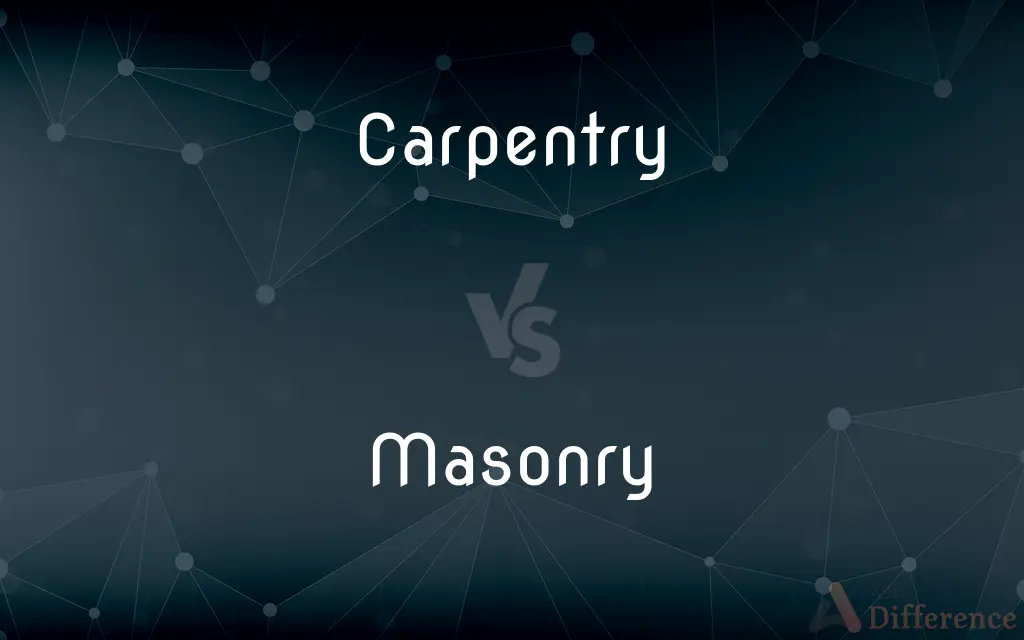Carpentry vs. Masonry — What's the Difference?
By Tayyaba Rehman — Updated on September 17, 2023
Carpentry involves working with wood to construct or repair structures like furniture and buildings. Masonry deals with the construction of structures using bricks, stones, or concrete blocks.

Difference Between Carpentry and Masonry
Table of Contents
ADVERTISEMENT
Key Differences
Carpentry and Masonry are both skilled trades that involve the construction or repair of structures, but they differ significantly in the materials and techniques they use. Carpentry primarily focuses on working with wood to build things like furniture, houses, and other wooden structures. Carpentry uses tools such as saws, hammers, and nails to accomplish its tasks.
On the other hand, Masonry is concerned with constructing structures using bricks, stones, or concrete blocks. Mortar is often used to bind these materials together. Masonry projects can include everything from building walls and laying foundations to constructing chimneys and fireplaces. Masons use different tools like trowels, chisels, and levels.
Another distinction between Carpentry and Masonry is the level of detail and finishing work involved. In Carpentry, the finish is often a crucial part of the job, requiring sanding, staining, or painting. Masonry, on the other hand, may involve less finishing work, as the materials used are often decorative in themselves, like natural stone or patterned brick.
In summary, Carpentry and Masonry are both essential trades in the construction industry but differ in their focus, materials, and tools. Carpentry works primarily with wood, while Masonry works with stone, brick, or concrete. Both have unique sets of skills and techniques, making them indispensable for different types of construction projects.
Comparison Chart
Primary Material
Wood
Brick, Stone, Concrete
ADVERTISEMENT
Tools Used
Saws, Hammers, Nails
Trowels, Chisels, Levels
Final Finish
Requires more finishing
May require less finishing
Types of Structures
Furniture, Houses
Walls, Foundations, Chimneys
Skill Set
Woodworking, Finishing
Bricklaying, Stonework
Compare with Definitions
Carpentry
Carpentry includes tasks like cutting, fitting, and joining wood.
The carpentry in this cabinet is exquisite.
Masonry
Masonry involves building structures with bricks, stones, or concrete.
The masonry work on the fireplace was intricate.
Carpentry
Carpentry can also involve architectural detailing.
The carpentry details added charm to the old house.
Masonry
Masonry is the craft of laying and binding building materials.
Masonry skills are essential for constructing durable walls.
Carpentry
Carpentry is the skill of making things out of wood.
He learned carpentry from his grandfather.
Masonry
Masonry is the building of structures from individual units, which are often laid in and bound together by mortar; the term masonry can also refer to the units themselves. The common materials of masonry construction are brick, building stone such as marble, granite, and limestone, cast stone, concrete block, glass block, and adobe.
Carpentry
Carpentry often requires finishing work like sanding or painting.
After the carpentry was done, they sanded the wood.
Masonry
Masonry includes tasks like leveling, measuring, and cutting.
The masonry required precise measurements.
Carpentry
Carpentry involves the construction and repair of wooden structures.
The carpentry work on the house took several weeks.
Masonry
Stonework
Cracks in the finished masonry
Masonry nails
Carpentry
Carpentry is a skilled trade and a craft in which the primary work performed is the cutting, shaping and installation of building materials during the construction of buildings, ships, timber bridges, concrete formwork, etc. Carpenters traditionally worked with natural wood and did rougher work such as framing, but today many other materials are also used and sometimes the finer trades of cabinetmaking and furniture building are considered carpentry.
Masonry
Freemasonry
The ‘degrees’ found in Masonry are symbolic practices
Carpentry
The work or trade of a carpenter.
Masonry
The trade of a mason.
Carpentry
Woodwork done by a carpenter
A room that was appointed with fine carpentry.
Masonry
Work done by a mason.
Carpentry
(uncountable) The trade of cutting and joining timber in order to construct buildings or other structures; woodworking.
Masonry
Stonework or brickwork.
Carpentry
(countable) A carpenter's workshop.
Masonry
Masonry Freemasonry.
Carpentry
(uncountable) A collection of timber connected by being framed together, as the pieces of a roof, floor, etc.; work done by a carpenter.
Fine carpentry for sale.
Masonry
The art or occupation of a mason.
He studied masonry for five years.
Carpentry
The art of cutting, framing, and joining timber, as in the construction of buildings.
Masonry
The work or performance of a mason
The masonry was exquisite.
Carpentry
An assemblage of pieces of timber connected by being framed together, as the pieces of a roof, floor, etc.; work done by a carpenter.
Masonry
That which is built by a mason; anything constructed of the materials used by masons, such as stone, brick, tiles, or the like. Dry masonry is applied to structures made without mortar.
The masonry was cracked.
Carpentry
The craft of a carpenter: making things out of wood
Masonry
The craft, institution, or mysteries of Freemasons; Freemasonry.
Masonry
The art or occupation of a mason.
Masonry
The work or performance of a mason; as, good or bad masonry; skillful masonry.
Masonry
That which is built by a mason; anything constructed of the materials used by masons, such as stone, brick, tiles, or the like. Dry masonry is applied to structures made without mortar.
Masonry
The craft, institution, or mysteries of Freemasons; freemasonry.
Masonry
Structure built of stone or brick by a mason
Masonry
Freemasons collectively
Masonry
The craft of a mason
Masonry
Masonry can be decorative or structural.
The decorative masonry added value to the home.
Masonry
Masonry often uses mortar as a binding agent.
The masonry used a special type of mortar for better durability.
Common Curiosities
What materials are used in Carpentry?
Wood is the primary material used in carpentry.
What tools are common in Masonry?
Trowels, chisels, and levels are used in masonry.
What materials are used in Masonry?
Masonry mainly uses bricks, stones, and concrete.
Is finishing work more common in Carpentry?
Yes, carpentry often involves additional finishing work like sanding or painting.
How long does it take to become skilled in Masonry?
It typically takes 3-4 years of training or apprenticeship.
What is Masonry?
Masonry is the art of building structures using bricks, stones, or concrete blocks.
Do carpenters and masons need different training?
Yes, each requires specialized training focused on their respective materials and techniques.
Is Masonry used for decorative purposes?
Yes, masonry can be both decorative and structural.
Is Carpentry more versatile than Masonry?
Carpentry is versatile in working with wood, while masonry specializes in working with bricks, stones, and concrete.
Are Carpentry and Masonry related?
Both are skilled trades in the construction industry but focus on different materials and techniques.
How long does it take to become skilled in Carpentry?
It varies, but apprenticeships can last 3-4 years.
Can Carpentry and Masonry work overlap?
Yes, in projects like building a home, both carpenters and masons may be involved.
What is Carpentry?
Carpentry is the craft of building and repairing wooden structures.
What tools are common in Carpentry?
Saws, hammers, and nails are common carpentry tools.
Which is older, Carpentry or Masonry?
Both are ancient crafts, but masonry is considered one of the oldest forms of construction.
Share Your Discovery

Previous Comparison
Gadget vs. Device
Next Comparison
Monsoon vs. CycloneAuthor Spotlight
Written by
Tayyaba RehmanTayyaba Rehman is a distinguished writer, currently serving as a primary contributor to askdifference.com. As a researcher in semantics and etymology, Tayyaba's passion for the complexity of languages and their distinctions has found a perfect home on the platform. Tayyaba delves into the intricacies of language, distinguishing between commonly confused words and phrases, thereby providing clarity for readers worldwide.














































